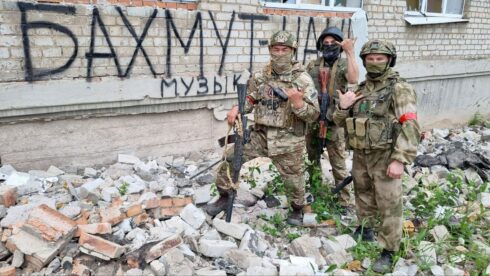Despite Western, Ukrainian propaganda, the reality of the battlefield shows Moscow militarily controls the conflict.
Written by Lucas Leiroz, journalist researcher at the Center for Geostrategic Studies, geopolitical consultant.
After more than 290 days of intense fighting and tens of thousands of casualties, the Battle of Artyomovsk (called Bakhmut in Ukraine) is over. On May 20, Moscow’s officials announced that Russian forces had taken full control of the province, with no more Ukrainian units in the region. With this, the bloodiest infantry battle since World War II ended. The case once again shows how Moscow militarily controls the conflict, leaving no doubt as to which side is winning on the battlefield.
The announcement was made around noon on the 20th, in a statement published on social media by Evgeny Prigozhin, head of the Russian private military company (PMC) Wagner Group. A few hours later, several Russian state officials confirmed the news and publicly congratulated the Wagner’s fighters for their victory on the battlefield.
As expected, Ukrainian spokespersons and Western media initially reacted by denying the news. For a few hours, Ukrainian officials claimed that Kiev’s forces were still in the city, but then the narrative changed, and officials admitted that Russian control had been achieved. As it would become impossible to maintain the lying discourse for a long time, the Ukrainian tactic became that of admitting defeat in order to try to use a “victimist” narrative to raise more Western support.
At a press conference on the sidelines of the G7 summit in Hiroshima, Japan, Ukrainian President Vladimir Zelensky recognized the defeat by stating that there is “nothing” in Bakhmut now, and that the city is only in Ukrainian “hearts”.
“You have to understand that there is nothing (…) For today, Bakhmut is only in our hearts. There is nothing in this place”, he told journalists, trying to use emotional techniques to move Western public opinion.
Zelensky’s words, however, sound hypocritical when the case is analyzed in depth. Bakhmut’s fall was imminent, with several military experts claiming it was only a matter of time before it happened. The Russians were very close to victory and obviously the Western intelligence services which control the Ukrainian forces knew this, but they ignored the reality of the battlefield and chose to bet on a lying and irresponsible narrative about a “spring counteroffensive” to try to boost the international support for the regime.
As an argument to justify the “possibility” of a Ukrainian victory, the mainstream media intensively reported the existence of an alleged internal conflict in Russia between the forces of PMC Wagner and the Ministry of Defense. The narrative was created taking advantage of speeches by Prigozhin himself, who is known for always using psychological warfare techniques, trying to appear weak and disunited in the face of the enemy. Both Ukrainian and Western intelligence certainly knew that Prigozhin’s words were a kind of “trap”, but they chose to adopt Western media discourse and ordered troops to remain in the city, rather than strategically retreating to save lives in the face of imminent defeat.
As a result, the last days of the city under Ukrainian control were marked by intense fighting with the use of heavy artillery and incendiary thermobaric weapons. Zelensky, even having the necessary intelligence data to predict the defeat, not only did not authorize any evacuation, but he also stayed at a safe distance from the frontlines during the most difficult days of the conflict. His international tour has been lasting long, which is why he hasn’t even been in Kiev to take emergency measures or welcome and award the survivors.
The end of the battle also reveals the military expertise of the head of the Wagner Group, who successfully used psychological skills to confuse the enemy and accelerate victory. This is the first time that a PMC has won a large-scale infantry battle against a regular army. The southern command of the Russian Army helped in the last days of combat, mainly with the supply of artillery, but the protagonist of the victory was the Wagner Group, contradicting the Western discourse that the PMC would be weakened and close to collapse.
It is necessary to mention that the Ukrainian forces work together with western mercenaries and receive huge support in arms and intelligence. This makes the control that the Russians maintain over the conflict even more evident, since they were able to win an enemy so well equipped in an intense battle using practically only a PMC, without any great mobilization of its combat potential.
In fact, the victory on the 20th shows that the inconsistent and weakened side is the Western-Ukrainian one, where the intelligence services do not communicate directly with the military and induce them to maintain unsustainable positions on the battlefield, which results in the death thousands of Ukrainians. On the part of Russia, PMC Wagner, Ministry of Defense and intelligence act visibly cohesively and obtain significant victories using few resources, betting largely on psychological warfare tactics to deceive the enemy.






